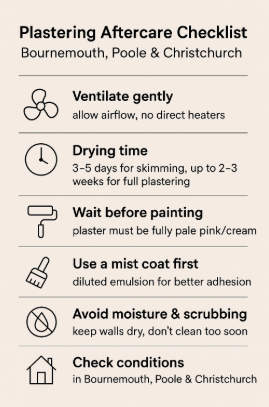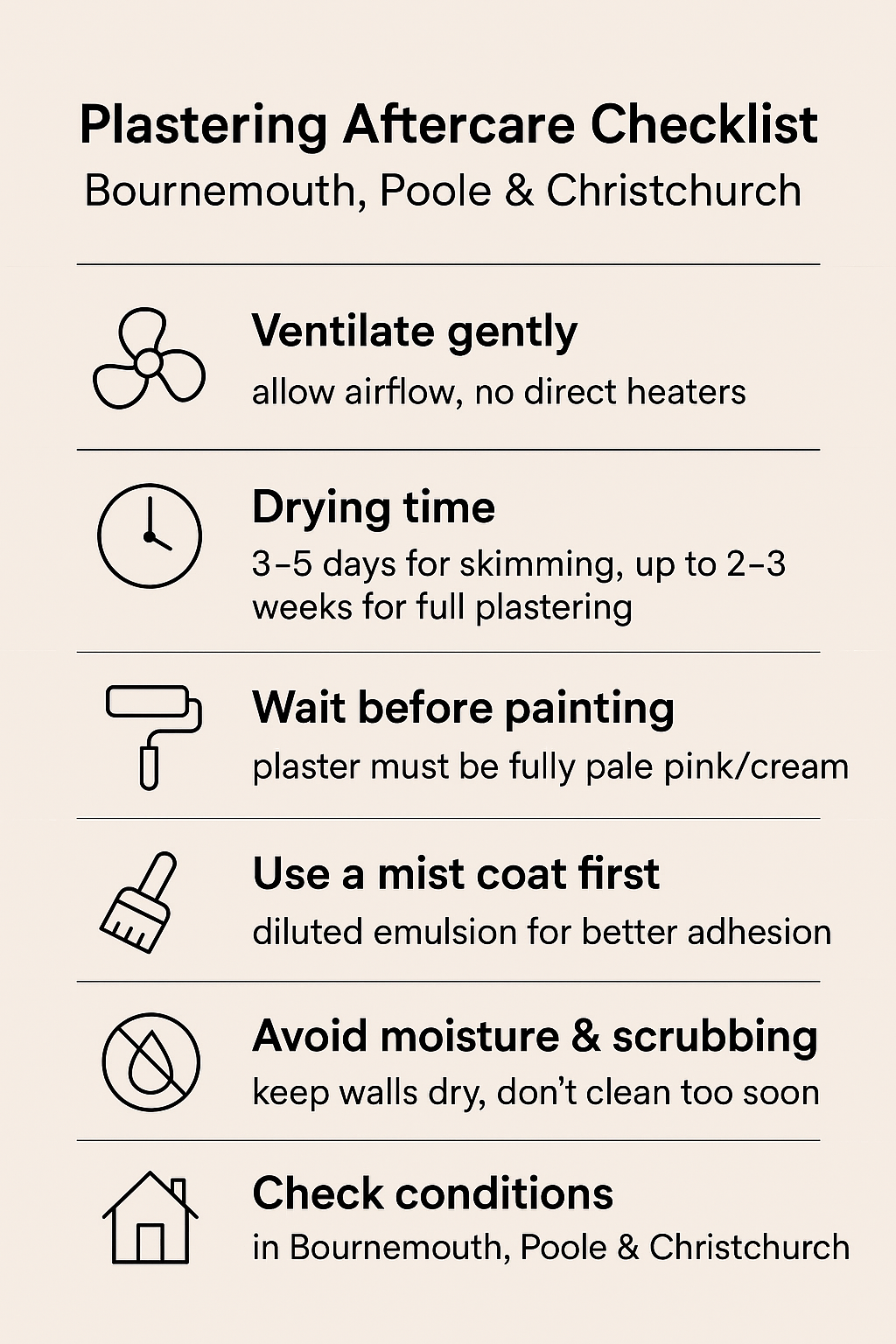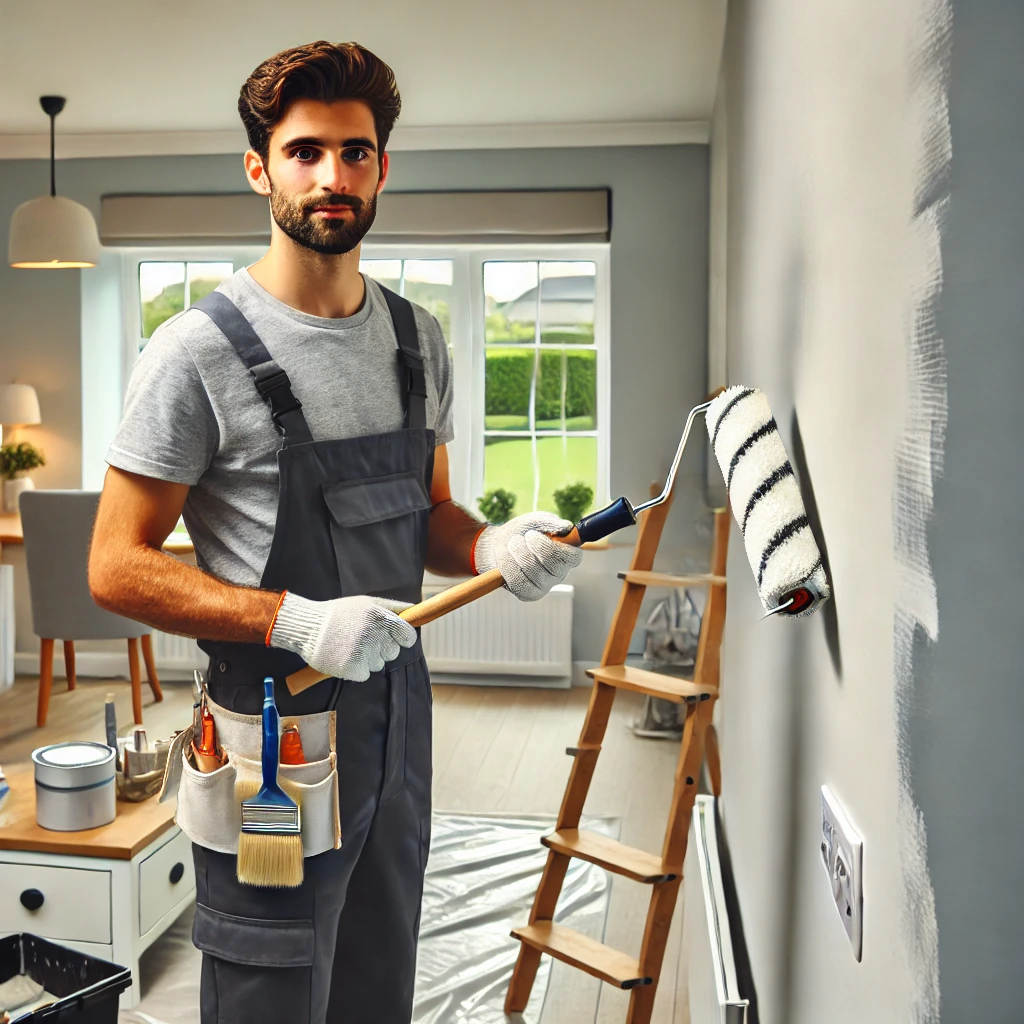Discover expert plastering aftercare tips
When your plastering project is finally complete, it’s tempting to rush into decorating straight away. But as any plastering specialist with over 20 years of hands-on experience in Bournemouth, Poole, and Christchurch will tell you: proper aftercare for newly plastered walls and ceilings is absolutely crucial if you want a smooth, durable finish.
Whether you’ve just had a single wall skimmed or a full room re-plastered, what you do in the days and weeks after the work is just as important as the plastering itself. In this guide, we’ll walk you through professional plaster aftercare tips, answer common questions like “How long after plastering can I paint?”, and share insider advice to ensure your plaster sets beautifully.
Why Aftercare Matters in Plastering
Fresh plaster may look solid within hours, but it’s still undergoing a delicate curing process. Rushing into painting, cleaning, or exposing your walls to moisture too soon can cause:
- Cracking and crazing
- Flaking paint or poor adhesion
- Uneven drying patches (“plaster bloom”)
- Long-term structural weaknesses
As professional plasterers serving Bournemouth, Poole, and Christchurch, we often get called back to fix problems caused by poor aftercare—issues that could easily have been avoided with the right approach.
Step 1: Let Your Plaster Breathe
Good ventilation is essential in the early days. Open windows and keep the air moving where possible, but avoid blasting heaters directly at the walls. Sudden, forced drying can cause plaster to shrink and crack.
Pro Tip: In Dorset homes, especially near the coast where humidity levels can be high, make sure you balance ventilation with protection from damp sea air. Gentle airflow works best.
Step 2: Allow Sufficient Drying Time
So, how long does plaster take to dry?
- Small skim coats – 3 to 5 days on average
- Full re-plastering jobs – up to 2–3 weeks, depending on room size and conditions
- Colder or damper homes in Bournemouth, Poole, or Christchurch – allow extra time
You’ll know your plaster is dry when it changes from a dark, damp brown to a consistent pale pink colour. Never be tempted to paint before this stage.
Step 3: When Can You Paint After Plastering?
One of the most common questions homeowners ask is:
“How long after plastering can I paint my walls?”
The rule of thumb: wait until plaster is fully dry.
Once ready, always begin with a mist coat (a watered-down emulsion) to allow the paint to soak into the plaster and create a good bond. Skip this step, and you risk peeling or patchy paintwork later on.
Pro Tip: In older properties around Christchurch and Poole, where walls may naturally retain more moisture, extend your drying period for a flawless result.
Step 4: Avoid Heavy Cleaning or Impact
Do not scrub or wash newly plastered walls. Even light cleaning can damage the surface while it’s curing. Similarly, avoid knocking or hanging items too soon—plaster is still fragile in its early stages.
Step 5: Control the Environment
Keep your room as dry as possible. Excess humidity from activities like drying clothes indoors can slow the process dramatically. If needed, a dehumidifier can help, but always use it on a gentle setting.
Professional Plastering Aftercare Checklist
Here’s a quick reference to keep your plaster in top condition:
- Maintain steady airflow – windows open, but no direct heat
- Allow at least 5–14 days (depending on job size) before painting
- Look for uniform pale colouring before applying paint
- Use a mist coat first before finishing coats
- Keep the room dry, avoid scrubbing or knocking the surface
Local Expertise Matters
Every home is different. Coastal properties in Bournemouth, Poole, and Christchurch face unique challenges such as higher humidity and salt in the air, which can influence drying times and long-term plaster performance. With over 20 years of plastering experience in the Dorset area, we understand these local conditions and can give tailored advice for your home.
Plastering Aftercare FAQs (Bournemouth, Poole & Christchurch)
1. Can I speed up plaster drying?
It’s best not to. Forcing plaster to dry with heaters or fans can cause cracks. Instead, maintain gentle airflow with open windows and let the plaster dry naturally. If necessary, a low-setting dehumidifier can help in damp properties.
2. What’s the best paint for new plaster?
The first coat should always be a mist coat made from diluted emulsion paint. For finishing coats, choose a breathable, water-based emulsion. Avoid vinyl or oil-based paints in the early stages as they can trap moisture.
3. How can I tell if my plaster is dry enough to paint?
Plaster changes colour as it dries. Look for a consistent pale pink or light cream shade across the whole surface. Any darker patches mean moisture is still present, so wait longer before painting.
4. Does plaster dry quicker in summer than winter?
Yes, in warmer months with lower humidity, plaster can dry faster. However, in coastal areas like Bournemouth and Poole, summer humidity can sometimes slow down drying, so always judge by colour rather than the calendar.
5. Should I seal new plaster before painting?
No specialist sealant is needed. A mist coat of emulsion acts as the perfect sealer for new plaster, allowing your final coats to adhere properly without peeling.
Ready to Transform Your Walls?
Proper aftercare when plastering your room ensures a long-lasting, flawless finish. But the results always start with expert plastering in the first place.
If you live in Bournemouth, Poole, or Christchurch and need professional plastering services, repairs, or tailored aftercare advice, we’d be happy to help. With over two decades of experience across Dorset homes, we guarantee a finish that not only looks stunning but also stands the test of time.
Request Your Free Plastering Quote Today
- Serving Bournemouth, Poole, Christchurch, and surrounding Dorset areas
- Over 20 years’ plastering expertise
- Reliable, clean, and professional service
Contact us now to arrange a free no-obligation quote and expert plastering advice tailored to your home.


